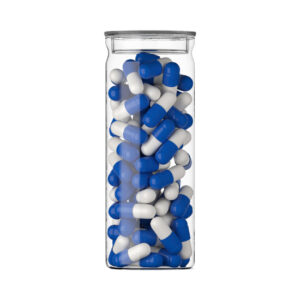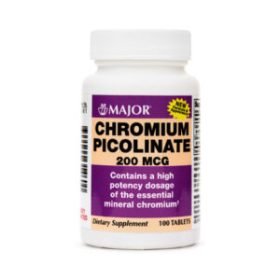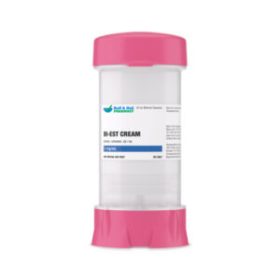Biotin / Minoxidil Capsule (Each)
Biotin and Minoxidil – Key Information
Biotin
Biotin, also known as vitamin H or coenzyme R, is a B-complex vitamin that plays a crucial role in the body’s metabolism. It helps break down carbohydrates, fats, and proteins by acting as a cofactor for enzymes involved in these processes. Additionally, biotin is important for gene expression, cell communication, and histone modification. Since the body cannot produce enough on its own, it must be obtained through food. Good dietary sources include liver, kidneys, muscles, eggs, fish, seeds, and nuts.
Biotin supplements are commonly recommended for improving hair and nail health, managing conditions like seborrheic dermatitis in specific metabolic disorders, biotin deficiency, diabetes, nerve pain, fungal infections, and elevated cholesterol. It may also be used during pregnancy or in patients undergoing dialysis, as deficiency is more likely in these groups. Biotin is also found in various cosmetic products and has applications in cancer treatment through radiolabeled forms used in targeted therapies.
Minoxidil
Minoxidil is available in both oral and topical forms, with different uses. Oral minoxidil is a prescription medication mainly used for severe, treatment-resistant high blood pressure, while topical minoxidil is widely used for hair loss, especially hereditary alopecia. It stimulates hair growth in about 30% of men and 60% of women, though some users experience only minor improvement or prevention of further hair loss.
First discovered in 1965, oral minoxidil was approved in 1979 for hypertension, while topical formulations gained approval in the late 1980s and 1990s for alopecia. Over time, higher-strength solutions, such as the 5% topical formula, were introduced to improve hair regrowth more quickly and effectively. The foam version, approved in 2006, offers added benefits like fewer irritants and faster drying. Today, minoxidil is a popular and effective treatment option for managing hair thinning and loss in both men and women.
Biotin
A watersoluble B vitamin, biotin is found naturally in several foods and is also sold as a supplement. Metabolizing lipids, carbs, and proteins depends on it. Found mostly in liver, kidney, and muscle tissues, vitamin B is abundant in foods including organ meats, eggs, nuts, and soybeans. Enzymatically broken down in the digestive system, biotin-containing proteins into biocytin next split into free biotin and lysine by the enzyme biotinidase. The body uses the free biotin absorbed in the small intestine. Essential for assisting enzyme systems that control fatty acid, glucose, and amino acid metabolism, biotin helps. Managing metabolic diseases including biotinidase deficiency, holocarboxylase synthetase deficiency, and other uncommon enzyme-related conditions is especially useful.
Minoxidil
A strong vasodilator, minoxidil relieves arterial smooth muscles hence decreasing peripheral resistance and blood pressure. Unlike other drugs, it doesn’t disrupt adrenergic nerves or block the central nervous system; it still works even in their absence. The way the drug works could be related to the buildup of cyclic adenosine monophosphate (cAMP), which promotes blood vessel relaxation. The body, however, reacts to minoxidil with elevated heart rate, stroke volume, and renin activity, which causes sodium and water retention. These consequences can compromise its blood pressure-lowering effects; hence, taking minoxidil in conjunction with either a beta-blocker or, in some instances, methyldopa is advised. Managing fluid accumulation calls in part on loop diuretics.
Mainly dilating arterioles, minoxidil may lead to postural hypotension. Because of reflex stimulation, it may aggravate left ventricular hypertrophy rather than relieve it. Interestingly, the hair growth results of minoxidil seem unrelated to its effects on blood pressure. Though its mechanism is not totally clear, it is thought to shorten the resting phase of the hair growth cycle and may affect calcium balance in hair cells, therefore stimulating regrowth especially in thinning areas.
biotin
Essential for energy metabolism, biotin is a watersoluble vitamin aiding in the breakdown of fats, carbohydrates, and proteins. High biotin levels, from 10 mg to 300 mg per day, can, however, impede some lab tests using biotinbased technology. Such interference could cause wrong results, including falsely low levels of the cardiac enzyme (troponin), so leading to wrong diagnosis and possibly serious consequences. Biotin interference has in some instances been associated with fatal negative effects. Healthcare professionals should always ask about supplement use and let labs know if patients are taking biotin pills. Should test results conflict with a patient’s symptoms, it is imperative to think about biotin interference and notify regulatory authorities like the FDA of such events.
Eating biotin at suggested dietary levels is harmless during pregnancy and breastfeeding, and more supplementation is often unnecessary unless a deficiency is verified.
Minoxidil
Minoxidil, used orally for serious hypertension and topically for hair loss, is a strong vasodilator that lowers blood pressure but can induce reflex tachycardia and other heart-related problems. For patients with cardiovascular illnesses such angina or coronary artery disease, it is not recommended as the decline in blood pressure could worsen their condition. Pericardial effusion is another side effect; in extreme cases, it might develop into cardiac tamponade. Oral minoxidil should be cautiously combined with betablockers and diuretics to regulate fluid retention and avoid fast heart rate rises.
Patients with kidney illness, pulmonary hypertension, or heart failure should shun minoxidil because it might increase pulmonary pressures or exacerbate fluid retention. Because of the possibility of too much hormone release, it is forbidden for persons with pheochromocytoma. Although topical minoxidil is usually harmless, skin damage can improve its absorption and hence cause systemic consequences. Because agerelated health changes call for a lower starting dose in elderly individuals. To guarantee safety, close monitoring and customized treatment programs are absolutely necessary.
Biotin and Drug Interactions
Biotin, a key nutrient for metabolism, can be affected by certain medications when taken together for extended periods. Anticonvulsants such as phenobarbital, carbamazepine, phenytoin, primidone, and fosphenytoin are known to induce enzymes like CYP3A4, which accelerate the breakdown of biotin in the body. This leads to reduced biotin levels and impaired absorption in the intestines, potentially limiting its benefits. These effects are more likely when these medications are used for over a year. It’s important for healthcare providers to review patients’ supplement use, especially if they are on these anticonvulsants, and monitor their biotin status.
Additionally, belladonna alkaloids, ergotamine, and other medications with similar enzyme-inducing properties may also contribute to lower biotin levels. Educating patients about potential interactions and monitoring their nutritional status can help prevent deficiencies.
Dietary factors can also influence biotin absorption. Avidin, a protein in raw egg whites, binds strongly to biotin and blocks its uptake in the gut. However, cooking egg whites deactivates avidin, allowing normal absorption.
Excessive alcohol consumption may increase urinary magnesium loss and should be limited while using magnesium supplements, as this can compound nutrient depletion.
Minoxidil Interactions
Topical minoxidil, commonly used for hair growth, can interact with other substances. For example, systemic cyclosporine may amplify side effects such as excessive hair growth (hypertrichosis), which tends to improve after stopping minoxidil. Similarly, baby aspirin may reduce the effectiveness of topical minoxidil by inhibiting sulfotransferase enzymes that are essential for its action on hair follicles.
Patients using minoxidil should be informed about these interactions and monitored for side effects or reduced efficacy when used alongside other treatments.
Biotin
Usually rather safe, biotin is sometimes taken in large quantities. Adverse consequences are very uncommon. Still, there is a said case where an elderly woman developed a lifethreatening disease known as eosinophilic pleuropericardial effusion following 10 mg of biotin along with 300 mg of pantothenic acid per day for two months. Such events are remarkable and not usually observed in most consumers.
Minoxidil
The side effects of minoxidil differ based on its manner of application. Rarely does topical minoxidil, which is administered straight to the skin, cause systemic effects. Mild skin-related problems like itching, redness, or dryness comprise most of the reactions observed. Oral minoxidil, on the other hand, is a stronger drug with more significant side effects.
Minoxidil decreases blood pressure by relaxing blood arteries. But this can also make the body retain salt and water, resulting in edema (swelling). This fluid accumulation can happen fast without diuretics. Some patients get headaches; in uncommon cases, swelling can become therapy-resistant.
Another frequent problem is reflex tachycardia, which involves a quicker heartbeat to make up for reduced blood pressure. This can aggravate angina and other diseases. One’s actions might be forestalled by a betablocker.
Lab tests may reveal transitory changes including a little decrease in red blood cells and rises in creatinine, blood urea nitrogen, and alkaline phosphatase. Though these usually level off once you cease the medicine.
One major adverse effect of oral minoxidil is unwelcome hair development on the face, limbs, or scalp; this usually goes back once the drug is stopped.
In rare cases, severe skin reactions like Stevens-Johnson syndrome or bullous eruptions have been noted. Oral consumption can also cause nausea and vomiting.
Though seen to be less dangerous, topical minoxidil can cause skin irritation.
Biotin
During pregnancy, biotin can be safely consumed at the recommended adequate intake (AI) level. If a healthy diet is followed and no deficiency is diagnosed, extra supplementation is usually unnecessary. Similarly, breastfeeding women can meet their biotin needs through food sources without additional supplements unless advised otherwise by a healthcare provider.
Minoxidil
Minoxidil is classified as pregnancy risk category C. While there are no well-conducted human studies on its effects during pregnancy, animal studies have raised concerns. These studies showed potential issues like reduced fertility and lower survival rates in offspring. One case even reported facial deformities and excessive hair growth in an infant whose mother took 10 mg of minoxidil daily during pregnancy. Therefore, doctors must carefully weigh the risks and benefits before prescribing minoxidil to pregnant women.
For breastfeeding mothers, manufacturers advise against using minoxidil, although some experts believe it may be generally compatible with nursing. There is limited evidence, but in one case, a mother taking 5 mg twice daily had minoxidil pass into her breast milk without causing harm to the baby over two months. Still, the long-term effects are unclear. Because of this uncertainty, other blood pressure medications such as enalapril, hydrochlorothiazide, methyldopa, or propranolol might be safer alternatives.
It’s not known whether topical minoxidil enters breast milk, but caution is advised. Healthcare providers are encouraged to consider the benefits of breastfeeding, potential risks to the infant from drug exposure, and the dangers of untreated conditions. Any suspected adverse effects in nursing infants should be reported to the FDA for further investigation.
Store this medication at 68°F to 77°F (20°C to 25°C) and away from heat, moisture and light. Keep all medicine out of the reach of children. Throw away any unused medicine after the beyond-use date. Do not flush unused medications or pour down a sink or drain.
- Office of Dietary Supplements. Biotin fact sheet for health professionals. September 2018. Internet version, retrieved June 24, 2019. Available on the World Wide Web at: https://ods.od.nih.gov/factsheets/Biotin-HealthProfessional/– LinkOpens in New Tab
- DeVillez RL. The Therapeutic Use of Topical Minoxidil. Dermatol Clin 1990;8:367-74.
- Olsen EA, Dunlap FE, Funicella T, et al. A randomized clinical trial of 5% topical minoxidil versus 2% topical minoxidil and placebo in the treatment of androgenetic alopecia in men. J Am Acad Dermatol 2002;47:377-85.
- Olsen EA, Whiting D, Bergfeld W, et al. A multicenter, randomized, placebo-controlled, double-blind clinical trial of a novel formulation of 5% minoxidil topical foam versus placebo in the treatment of androgenetic alopecia in men. J Am Acad Dermatol 2007;57(5):767-74. Epub 2007 Aug 29
- Standing Committee on the Scientific Evaluation of Dietary Reference Intakes-Panel on Folate, Other B Vitamins, and Choline and the Subcommittee on Upper Reference Levels of Nutrients, Food and Nutrition Board, Institute of Medicine (IOM). Dietary Reference Intakes for Thiamine, Riboflavin, Niacin, Vitamin B6, Folate, Vitamin B12, Pantothenic Acid, Biotin and Choline. 1999, 2000. The National Academy of Sciences Press, Washington DC.
- Bauer JH, Alpert MA. Rapid reduction of severe hypertension with minoxidil. J Cardiovasc Pharmacol 1980;2 Suppl:S189-99.
- Alpert MA, Bauer JH. Rapid control of severe hypertension with minoxidil. Arch Intern Med 1982;142(12):2099-104.
- Pogatsa-Murray G, Varga L, Varga A, et al. Changes in left ventricular mass during treatment with minoxidil and cilazapril in hypertension patients with left ventricular hypertrophy. J Hum Hypertens 1997;11(3):149-56.
- Buhl AE. Minoxidil’s action in hair follicles. J Invest Dermatol 1991;96:73S-4S.
- Messenger AG, Rundegren J. Minoxidil: mechanisms of action on hair growth. Br J Dermatol 2004;150:186-194.
- Sato T, Tadokoro T, Sonoda T, et al. Minoxidil increases 17b-hydroxysteroid dehydrogenase and 5a-reductase activity of cultured human dermal papilla cells from balding scalp. J Derm Sci 1999;19:123-5.
- US Food and Drug Administration (FDA). FDA Safety Communication: Update: The FDA warns that biotin may interfere with lab tests.
- Elston MS, Sehgal S, Toit SD, et al. Factitious graves’ disease due to biotin immunoassay interference – a case and review of the literature. J Clin Endocrinol Metab 2016;101(9):3251-3255.
- Loniten (minoxidil) tablets package insert. Kalamazoo, MI: Pharmacia; 2006 Feb.
- Health Care Financing Administration. Interpretive Guidelines for Long-term Care Facilities. Title 42 CFR 483.25(l) F329: Unnecessary Drugs. Revised 2015.
- Kaler SG, Patrinos ME, Lambert GH, et al. Hypertrichosis and congenital anomalies associated with maternal use of minoxidil. Pediatrics 1987;79:434-6.
- Minoxidil tablets package insert. Corona, CA: Watson Laboratories, Inc; 2009 Jun.
- American Academy of Pediatrics (AAP) Committee on Drugs. Transfer of drugs and other chemicals into human milk. Pediatrics 2001;108(3):776-789.
- Valdivieso A, Valdes G, Spiro TE, et al. Minoxidil in breast milk. Ann Intern Med. 1985;102:135. Letter.
- Fawcett WJ, Haxby EJ, Male DA. Magnesium: physiology and pharmacology. Br J Anaesth 1999;83:302-20.
- Fleming M, Mihic SJ, Harris RA. Ethanol. Gilman AG, Hardman JG, Limbird LE, (eds.) In: Goodman and Gilman’s The Pharmacological Basis of Therapeutics. 10th ed., New York, McGraw-Hill Companies. 2001:429-445.
- Badri T, Nessel TA, Kumar D D. Minoxidil. [Updated 2021 Dec 19]. In: StatPearls [Internet]. Treasure Island (FL): StatPearls Publishing; 2022 Jan-. Available from: https://www.ncbi.nlm.nih.gov/books/NBK482378/





